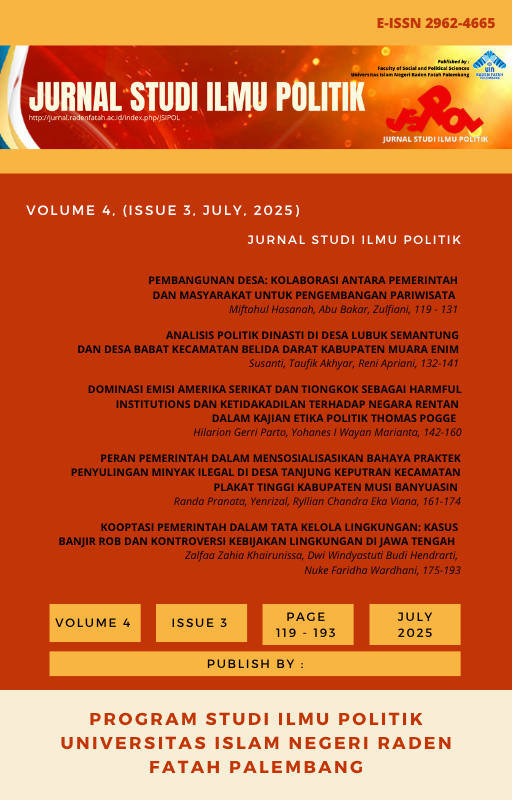DOMINASI EMISI AMERIKA SERIKAT DAN TIONGKOK SEBAGAI HARMFUL INSTITUTIONS DAN KETIDAKADILAN TERHADAP NEGARA RENTAN DALAM KAJIAN ETIKA POLITIK THOMAS POGGE
Main Article Content
Abstract
This study examines the dominance of carbon emissions by the United States (US) and China as a form of Harmful Institutions within the framework of Thomas Pogge’s political ethics. Together, these two countries account for over 40% of global annual emissions. However, their energy policies not only cause ecological damage but also create global structures that systematically disadvantage vulnerable nations. Countries such as the Maldives, Bangladesh, and regions in Sub-Saharan Africa, which have contributed minimally to the climate crisis, are suffering its most severe impacts. Through the principles of do no harm, compensatory justice, and institutional reform, Pogge offers a moral framework for evaluating the responsibility of major polluting states and advocating for structural reform in global climate governance. This study uses a qualitative analytical approach with case studies and the latest emissions data to explore ecological inequality and analyze how US and Chinese policies exacerbate the vulnerabilities of developing countries. The main findings indicate that climate justice requires the recognition of historical responsibility, fair compensation, and reform of international institutions. This research extends Pogge’s theory by incorporating transnational elements and intergenerational principles in constructing a roadmap toward a more ecologically and ethically just world order.
Downloads
Article Details

This work is licensed under a Creative Commons Attribution-ShareAlike 4.0 International License.
Authors who publish with this journal agree to the following terms:
- Authors retain copyright and grant the journal right of first publication with the work simultaneously licensed under a Creative Commons Attribution License that allows others to share the work with an acknowledgement of the work's authorship and initial publication in this journal.
- Authors are able to enter into separate, additional contractual arrangements for the non-exclusive distribution of the journal's published version of the work (e.g., post it to an institutional repository or publish it in a book), with an acknowledgement of its initial publication in this journal.
- Authors are permitted and encouraged to post their work online (e.g., in institutional repositories or on their website) prior to and during the submission process, as it can lead to productive exchanges, as well as earlier and greater citation of published work
How to Cite
References
Boston University Global Development Policy Center. (2023). China’s Global Energy Finance Database. Retrieved from https://www.bu.edu/gdp
Chen, Jindao, Qian Shi, Liyin Shen, Yao Huang, and Ya Wu. 2019. “What Makes the Difference in Construction Carbon Emissions between China and USA?” Sustainable Cities and Society 44:604–13. doi: 10.1016/j.scs.2018.10.017.
Carbon Brief. (2023). How US and China emissions caused $180bn of climate damage to poor countries in 2022. Retrieved from https://www.carbonbrief.org
Climate Accountability Institute. (2021). Carbon Majors Report. Retrieved from https://climateaccountability.org
Dai, Feng, Jijun Yang, Hao Guo, and Huaping Sun. 2021. “Tracing CO2 Emissions in China-US Trade: A Global Value Chain Perspective.” Science of The Total Environment 775:145701. doi: 10.1016/j.scitotenv.2021.145701.
Fahad, Shah, and Jianling Wang. 2020. “Climate Change, Vulnerability, and Its Impacts in Rural Pakistan: A Review.” Environmental Science and Pollution Research 27(2):1334–38. doi: 10.1007/s11356-019-06878-1.
Gao, Deting, and Guimei Feng. 2024. “The Roots of Carbon Emission Differences between China and USA: A Quantitative Study Based on Global Value Chains.” Journal of Environmental Management 365:121476. doi: 10.1016/j.jenvman.2024.121476.
Gills, Barry, and Jamie Morgan. 2020. “Global Climate Emergency: After COP24, Climate Science, Urgency, and the Threat to Humanity.” Globalizations 17(6):885–902. doi: 10.1080/14747731.2019.1669915.
Gregg, Jay S., Robert J. Andres, and Gregg Marland. 2008. “China: Emissions Pattern of the World Leader in CO 2 Emissions from Fossil Fuel Consumption and Cement Production.” Geophysical Research Letters 35(8). doi: 10.1029/2007GL032887.
Global Carbon Atlas. (2024). Emissions Database. Retrieved from https://www.globalcarbonatlas.org
Gardiner, S. M. (2011). A Perfect Moral Storm: The Ethical Tragedy of Climate Change. Oxford University Press.
Germanwatch. (2023). Global Climate Risk Index 2023. Retrieved from https://www.germanwatch.org/en/cri
Harris, P. G. (2021). China’s Climate Responsibility. Polity Press.
Hickel, J. (2020). The Divide: A Brief Guide to Global Inequality and its Solutions. Windmill Books.
International Monetary Fund (IMF). (2022). World Energy Subsidies Database. Retrieved from https://www.imf.org
L Rice, Jennifer, Joshua Long, and Anthony Levenda. 2022. “Against Climate Apartheid: Confronting the Persistent Legacies of Expendability for Climate Justice.” Environment and Planning E: Nature and Space 5(2):625–45. doi: 10.1177/2514848621999286.
Liu, Zhu, Jing Meng, Zhu Deng, Ping Lu, Dabo Guan, Qiang Zhang, Kebin He, and Peng Gong. 2020. “Embodied Carbon Emissions in China-US Trade.” Science China Earth Sciences 63(10):1577–86. doi: 10.1007/s11430-019-9635-x.
Ngcamu, Bethuel Sibongiseni. 2023. “Climate Change Effects on Vulnerable Populations in the Global South: A Systematic Review.” Natural Hazards 118(2):977–91. doi: 10.1007/s11069-023-06070-2.
Organisation for Economic Co-operation and Development (OECD). (2023). Climate Finance Provided and Mobilised by Developed Countries in 2022. Retrieved from https://www.oecd.org
Pogge, Thomas. 2005. “World Poverty and Human Rights.” Ethics & International Affairs 19(1):1–7. doi: 10.1111/j.1747-7093.2005.tb00484.x.
Roberts, J. T., & Parks, B. C. (2009). A Climate of Injustice: Global Inequality, North–South Politics, and Climate Policy. MIT Press.
Stokes, L. C. (2020). Short Circuiting Policy: Interest Groups and the Battle Over Clean Energy and Climate Policy in the American States. Oxford University Press.
Shui, Bin, and Robert C. Harriss. 2006. “The Role of CO2 Embodiment in US–China Trade.” Energy Policy 34(18):4063–68. doi: 10.1016/j.enpol.2005.09.010.
Tol, Richard S. J. 2021. “The Distributional Impact of Climate Change.” Annals of the New York Academy of Sciences 1504(1):63–75. doi: 10.1111/nyas.14497.
World Bank. (2023). Groundswell: Preparing for Internal Climate Migration. Retrieved from https://www.worldbank.org

